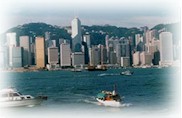|
|
| back | A city of eastern
China at the mouth of the Yangtze River (Chang Jiang) southeast of Nanjing. The largest
city in the country, Shanghai was opened to foreign trade by the Treaty of Nanking (1842)
and quickly prospered. France, Great Britain, and the United States all held large
concessions in the city until the early 20th century. Population, 6,980,000. The
municipality of Shanghai is administered as a separate governmental unit. Population,
12,170,000.
Shanghai is a famous historical and cultural city in China, an economic center where industry, trade and commerce, technology, finance, transportation and communication are concentrated, making it a cosmopolitan city, a venue for people from various countries and regions of the world. Shanghai is a flourishing city with a good and efficient transportation network. It is a melting pot of the cultures of the east and the west. Vested with rich manpower and cultural resources, and equipped with complete tourist amenities, it is a place where talented people from the world over like to gather. In addition, Shanghai also offers a variety of Chinese cuisine. Shanghai is also a hub of transportation in China. It is an avenue through which overseas visitors can better understand the Chinese society of the past and the present. Known as a nightless city, Shanghai at night still has many shops open for business along its main streets, under a myriad of blinking neon lights. The scene at the Bund, China's famous waterfront park, is even more colorful and charming. At this time of the night acrobatics, Peking opera, hotel shows and ballet will be held in theatres and hotels. Besides, you can also enjoy yourself by listening to happy and relaxed jazz music, rural music, disco and karaoke and others. The Shanghai Hongqiao International Airport is less than 10 miles west of the city centre. - SCENIC PLACES OF INTEREST - NANPU BRIDGE: Nanpu Bridge is situated across the Huangpu River, in the southeast of Shanghai city. It is the world's second, and Asia's largest and tallest twin-towered, double-cabled drawbridge, stretching 8.5 km. The towers have a height of 150 m while the main draw-bridge is 846 m long. With a net height of 46 m, 50,000-ton vessels can easily pass through under the bridge. During the night, the bridge looks even more picturesque under the luminous shower of over 600 lamps. On both sides of the bridge are four 50 m, fully computerized sightseeing lifts that add to the convenience of sightseers. Hours open for sightseeing: 01JAN96-31MAY96 - 8:30am-4:30pm 01JUN96-15OCT96 - 8:30am-10:00pm 16OCT96-31DEC96 - 8:30am-4:30pm THE OLD TOWN: It is easy to lose yourself in the narrow, winding alleys of Shanghai's Old Town. Stroll through the local bazaar, cross over the pond to Huxinting Teahouse, then rest in the Garden of Purple Clouds of Autumn. NANJING ROAD: Shanghai's -Fifth Avenue- offers China's greatest array of stores, restaurants, sweet shops, gift boutiques, and cozy night clubs. YU GARDEN: Built in 1559, Yu Garden is one of the famous classical gardens south of the Yangtze River. It is situated at the ancient City God Temple in Shanghai and occupies an area of 2 ha. The man made hills towering over one another add to the breathtaking scenery. Over 40 attractions within the garden are perfectly laid out and arranged. JADE BUDDHA TEMPLE: 8,000 square metres in area, this temple built in 1882 is one of the most famous temples in south China. Named Jade Buddha Temple because it houses a jade Buddha statue from Burma. THE FORMER RESIDENCE OF SOONG CHING LING: This garden building, 4,300 square metres in area, was where Madame Soong Ching Ling - widow of Dr. Sun Yat-Sen, worked and lived. THE HUANGPU RIVER: A cruise on the 110-kilometer-long Huangpu River brings visitors in touch with Shanghai's urban buildings, new industrial zones and the Yangtze River estuary. ANCIENT TOWNS IN THE REGION OF RIVERS AND LAKES: The Zhujiajiao, Luzhi and Zhoushi
towns scattered around Dianshan Lake present a typical landscape in the south of the
Yangtze River. Simple yet graceful buildings, rivers winding through the towns and small
bridges in various shapes. |
 Shanghai, a municipality under the direct
jurisdiction of the central government, covers an area of 6,341 square kilometers, of
which the city proper occupies 749 square kilometers. The newly opened Economic
Development Zone of Pudong, 518 square kilometers in area, is situated close to the city
proper with 1.38 million inhabitants. Within this new area is the Free Trade Zone -
Waigaoqiao Bonded Area. With 3 billion U.S. dollars of government funds pouring into the
infrastructure, another 10 billion U.S. dollars of investment is being spent on the new
city of offices, factories, apartments, schools, parks, a subway, light rail system and a
new airport. The money comes from both Chinese and foreign investors, who find Pudong a
new bonanza.
Shanghai, a municipality under the direct
jurisdiction of the central government, covers an area of 6,341 square kilometers, of
which the city proper occupies 749 square kilometers. The newly opened Economic
Development Zone of Pudong, 518 square kilometers in area, is situated close to the city
proper with 1.38 million inhabitants. Within this new area is the Free Trade Zone -
Waigaoqiao Bonded Area. With 3 billion U.S. dollars of government funds pouring into the
infrastructure, another 10 billion U.S. dollars of investment is being spent on the new
city of offices, factories, apartments, schools, parks, a subway, light rail system and a
new airport. The money comes from both Chinese and foreign investors, who find Pudong a
new bonanza.